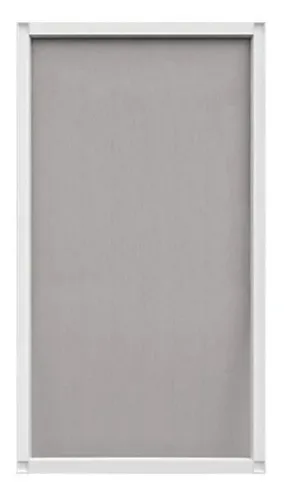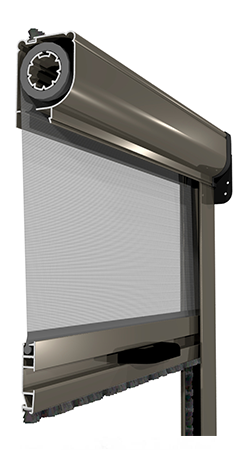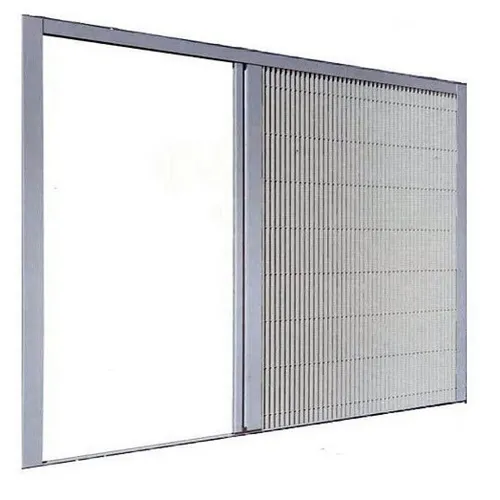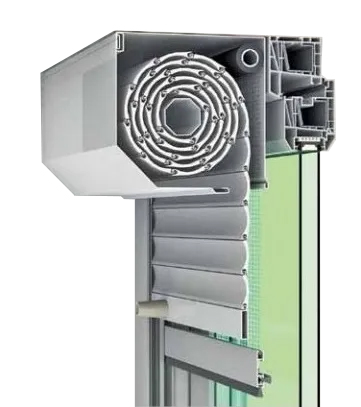
Hinged or Fixed Fly Nets
Hinged fly nets are the most common and affordable option for double-glazed windows, though they are less frequently used for single-opening doors.
The frame is made from extruded aluminium, painted in an electrostatic field to prevent peeling, while the mesh is made from carbon fibre, and the fittings are made from hard uPVC.
The hinged net features a light grey carbon fibre mesh that slightly reduces visibility (by about 15-20%) from inside to outside and is durable enough not to be torn by hand.
Fixed fly nets use the same mesh as the hinged version but are secured with fixed clips instead of hinges.
Hinged Fly Nets are designed for windows with a minimum of 20mm clearance around the outside of the opening.
Advantages
- Easy to maintain: These fly nets are easy to remove from the hinges and reposition with minimal effort.
- Available colours: Standard colours include white, dark brown (RAL 8019), light brown (RAL 8014), and anthracite grey (RAL 7016). They can also be customised to any RAL colour or wood shades like golden oak, walnut, or mahogany.
- Adaptability: They are compatible with both uPVC and aluminium frames, providing a perfect seal in both cases.
- Manoeuvrability: These nets can be easily removed without requiring specialised skills.
Lifespan
The lifespan of a hinged fly net is typically at least 5 years from installation. However, this can vary depending on how the net is used (e.g., if it is hit, knocked, or blown off by the wind) and how it is cleaned and stored during colder months
Roller Fly Nets
Roller fly nets are designed for both windows and doors, although they are less commonly used for doors. Unlike hinged screens, they operate vertically.
This system features an aluminium casing, and guides fitted with an anti-wind brush and shock absorber. The nets are operated via springs, making opening and closing much easier using the handle. The shock absorber ensures that if the net is accidentally released, it retracts smoothly into the box.
The profile, guides, and bottom grip of the roller fly net are made from extruded aluminium, painted in an electrostatic field for long-lasting durability.
These nets can be operated either vertically or horizontally, accommodating dimensions up to 2000 mm in width and 2400 mm in height.
Advantages
- Available colours: Standard colours include white, dark brown (RAL 8019), light brown (RAL 8014), and anthracite grey (RAL 7016). They can also be customised to any RAL colour or wood effect shades like golden oak, walnut, or mahogany.
- Increased reliability: These roller nets are highly durable, with a lifespan of at least 8 years when properly maintained and regularly cleaned of dust.
- Convenience: There’s no need to dismantle these nets in winter, as the box offers protection when the net is retracted. They can also be removed at any time without requiring specialised skills.
Lifespan
The expected lifespan of a roll-type fly net is a minimum of 8 years, though this can vary depending on how the net is used (e.g., if it is hit or forced).
Roller nets are securely fixed in position, with almost no risk of being blown away by the wind.


Pleated Fly Nets
Pleated fly nets are one of the latest and most innovative insect protection systems, having only recently appeared on the UK market.
These pleated fly nets are specifically designed for windows with large openings where no other type of screen can be fitted. The mesh is pleated in a fan-like structure, offering an elegant design and smooth operation.
Pleated fly nets are constructed with a 35mm thick frame made of extruded aluminium.
They can accommodate large dimensions, with widths up to 3000mm and heights up to 2800mm. They are typically installed on tilt-and-slide doors, sliding doors, or lift-and-slide doors.
Advantages
- Easy to use, these nets do not require additional space for opening or closing and can be easily installed on aluminium or PVC windows and doors.
- Pleated fly nets offer protection against insects, mosquitoes, and other pests and can be used on apartment windows and doors or as standalone units for spaces like gazebos, terraces, or other areas without windows.
Lifespan
The lifespan of a pleated fly net is typically at least 5 years from installation. However, this can vary depending on how the net is used (e.g., if it is hit, knocked, or blown off by the wind) and how it is cleaned and stored during colder months
Sliding Fly Nets
They are specifically designed for uPVC or aluminium doors with single or double openings and consist of a movable section that opens over a fixed section (similar in function to tilt-and-slide, smart slide, or lift-and-slide doors).
Sliding fly nets are commonly installed on single doors with a fixed window on either the right or left side, but they can also be fitted on double doors where one side slides. These nets are an ideal solution for uPVC or aluminium sliding windows and doors where other types of nets cannot be used. They are most often utilised for patio doors and are a reliable alternative to pleated nets.
While similar to pleated nets, sliding fly nets are more durable, though slightly more expensive.
Movement is facilitated by rubber or aluminium rollers (optional), with the frame made of extruded aluminium and the net composed of carbon fibre.
Advantages
- Available colours: They can be ordered in standard RAL colours such as white or brown, as well as any other RAL colour. Sliding fly nets are easy to use and cover large openings for patio or balcony doors.
- The frame is made of extruded aluminium, painted in an electrostatic field, while the fly net is made of carbon fibre, providing smooth and stylish accessibility with seamless sliding.
Lifespan
The lifespan of a sliding fly net is typically at least 5 years from installation. However, this can vary depending on how the net is used (e.g., if it is hit, knocked, or blown off by the wind) and how it is cleaned and stored during colder months

Overlapping Rolls vs Applied Rolls

Overlapping exterior blinds are blinds that are mounted on top of the window, at the same time as the windows are installed.

Applied external roller blinds are blinds that are installed after the installation of the windows.
External Rollers Blinds
External blinds provide shade, regulate temperature year-round, enhance privacy, and add an extra layer of security against burglary.
The slats are made from aluminium, filled with polyurethane foam, and are available in sizes of 39mm or 43mm, depending on the size of the roll.
Roller shutters help reduce heating costs in winter and electricity usage in summer. When closed, these aluminium blinds keep the temperature lower in summer as the foam-filled slats reflect heat outward. In colder months, they block over 40% of cold air from entering the home.
These external overlapping blinds can be operated manually using a ribbon or cord, or a crank for larger sizes. Alternatively, they can be controlled electrically via button, key, or remote control.
The casing is made of uPVC, square-shaped, and can be plastered externally. A roll-type fly net is integrated during the manufacturing process and operates vertically.
External blinds are available in standard colours such as white, brown, anthracite grey (RAL 7016), or silver. Wood-effect finishes like wenge, mahogany, golden oak, and walnut can also be ordered, typically matching the window frame.
Exterior roller blinds with increased anti-burglary rating
The outer blind, whether applied or overlapped, is generally considered a shading application and not necessarily a dedicated security application. So in the simple manual version, the roller provides a minimum degree of safety. This degree can be increased by adding some safety elements, such as:
- manual bolts
- automatic bolts
- lock key on the last lamella
- or anti-burglary clips for electrically operated rollers.
Still not sure? Request a callback
Drop us a line or write us a message with all your questions and we will be happy to answer them!

